Advanced Strategies for Poly(3-hydroxybutyrate-co-3-hydroxyvalerate) Production: PHA Synthase Homologous Overexpression in the Extremophile Haloferax mediterranei
Abstract
1. Introduction
2. Results
2.1. Construction of the phaEC Overexpression Strain
2.2. Growth Characterisation of H. mediterranei OEphaEC and Parental (HM26) Strains
2.3. PHBV Quantification in OEphaEC and Parental (HM26) Strains
2.4. Measurement of PHA Synthase Activity
2.5. Protein Extraction of OEphaEC and Parental (HM26) Strains and PhaE Location
2.6. TEM PHBV Granule Images
3. Discussion
4. Materials and Methods
4.1. PHA Synthase Overexpression Plasmid Construction
4.2. Culture Growth Conditions
4.3. PHBV Quantification from H. mediterranei HM26-OEphaEC and the Parental Strain HM26
4.4. PHA Synthase Activity Assay of OEphaEC and Parental (HM26) Strains
4.5. Protein Extraction of the OEphaEC and Parental (HM26) Strains
4.6. TEM Analysis
4.7. Statistical Analysis
5. Conclusions
Author Contributions
Funding
Institutional Review Board Statement
Data Availability Statement
Conflicts of Interest
References
- Jo, S.B.; Lim, S.H.; Lee, J.Y.; Son, J.; Choi, J.I.; Park, S.J. Microbial Production of Poly(3-Hydroxybutyrate-Co-3-Hydroxyvalerate), from Lab to the Shelf: A Review. Int. J. Biol. Macromol. 2024, 274, 133157. [Google Scholar] [CrossRef] [PubMed]
- Rai, P.K.; Lee, J.; Brown, R.J.C.; Kim, K.H. Micro- and Nano-Plastic Pollution: Behavior, Microbial Ecology, and Remediation Technologies. J. Clean. Prod. 2021, 291, 125240. [Google Scholar] [CrossRef]
- Krueger, M.C.; Harms, H.; Schlosser, D. Prospects for Microbiological Solutions to Environmental Pollution with Plastics. Appl. Microbiol. Biotechnol. 2015, 99, 8857–8874. [Google Scholar] [CrossRef]
- Vicente, D.; Proença, D.N.; Morais, P.V. The Role of Bacterial Polyhydroalkanoate (PHA) in a Sustainable Future: A Review on the Biological Diversity. Int. J. Environ. Res. Public Health 2023, 20, 2959. [Google Scholar] [CrossRef]
- Simó-Cabrera, L.; García-Chumillas, S.; Hagagy, N.; Saddiq, A.; Tag, H.; Selim, S.; Abdelgawad, H.; Agüero, A.A.; Sánchez, F.M.; Cánovas, V.; et al. Haloarchaea as Cell Factories to Produce Bioplastics. Mar. Drugs 2021, 19, 159. [Google Scholar] [CrossRef] [PubMed]
- Rivera-Briso, A.L.; Serrano-Aroca, Á. Poly(3-Hydroxybutyrate-Co-3-Hydroxyvalerate): Enhancement Strategies for Advanced Applications. Polymers 2018, 10, 732. [Google Scholar] [CrossRef]
- Kumar, M.; Singhal, A.; Verma, P.K.; Thakur, I.S. Production and Characterization of Polyhydroxyalkanoate from Lignin Derivatives by Pandoraea sp. ISTKB. ACS Omega 2017, 2, 9156–9163. [Google Scholar] [CrossRef] [PubMed]
- Mukherjee, A.; Koller, M. Microbial PolyHydroxyAlkanoate (PHA) Biopolymers—Intrinsically Natural. Bioengineering 2023, 10, 855. [Google Scholar] [CrossRef]
- Zher Neoh, S.; Fey Chek, M.; Tiang Tan, H.; Linares-Pastén, J.A.; Nandakumar, A.; Hakoshima, T.; Sudesh, K. Polyhydroxyalkanoate Synthase (PhaC): The Key Enzyme for Biopolyester Synthesis. Curr. Res. Biotechnol. 2022, 4, 87–101. [Google Scholar] [CrossRef]
- Obulisamy, P.K.; Mehariya, S. Polyhydroxyalkanoates from Extremophiles: A Review. Bioresour. Technol. 2021, 325, 124653. [Google Scholar] [CrossRef]
- Chen, J.; Cui, Y.; Zhang, S.; Wu, B.; Han, J.; Xiang, H. Unveiling the Repressive Mechanism of a PPS-like Regulator (PspR) in Polyhydroxyalkanoates Biosynthesis Network. Appl. Microbiol. Biotechnol. 2024, 108, 265–275. [Google Scholar] [CrossRef] [PubMed]
- Tan, G.Y.A.; Chen, C.L.; Li, L.; Ge, L.; Wang, L.; Razaad, I.M.N.; Li, Y.; Zhao, L.; Mo, Y.; Wang, J.Y. Start a Research on Biopolymer Polyhydroxyalkanoate (PHA): A Review. Polymers 2014, 6, 706–754. [Google Scholar] [CrossRef]
- Poli, A.; Di Donato, P.; Abbamondi, G.R.; Nicolaus, B. Synthesis, Production, and Biotechnological Applications of Exopolysaccharides and Polyhydroxyalkanoates by Archaea. Archaea 2011, 2011, 693253. [Google Scholar] [CrossRef]
- Collet, C.; Vaidya, A.A.; Gaugler, M.; West, M.; Lloyd-Jones, G. Extrusion of PHA-Containing Bacterial Biomass and the Fate of Endotoxins: A Cost-Reducing Platform for Applications in Molding, Coating and 3D Printing. Mater. Today Commun. 2022, 33, 104162. [Google Scholar] [CrossRef]
- Guo, M.; Stuckey, D.C.; Murphy, R.J. Is It Possible to Develop Biopolymer Production Systems Independent of Fossil Fuels? Case Study in Energy Profiling of Polyhydroxybutyrate-Valerate (PHBV). Green Chem. 2013, 15, 706–717. [Google Scholar] [CrossRef]
- Chen, Q.; Wang, Q.; Wei, G.; Liang, Q.; Qi, Q. Production in Escherichia Coli of Poly(3-Hydroxybutyrate-Co-3-Hydroxyvalerate) with Differing Monomer Compositions from Unrelated Carbon Sources. Appl. Environ. Microbiol. 2011, 77, 4886–4893. [Google Scholar] [CrossRef]
- Chen, G.Q.; Jiang, X.R. Next Generation Industrial Biotechnology Based on Extremophilic Bacteria. Curr. Opin. Biotechnol. 2018, 50, 94–100. [Google Scholar] [CrossRef]
- Koller, M.; Rittmann, S.K.M.R. Haloarchaea as Emerging Big Players in Future Polyhydroxyalkanoate Bioproduction: Review of Trends and Perspectives. Curr. Res. Biotechnol. 2022, 4, 377–391. [Google Scholar] [CrossRef]
- Rodge, S.P.; Dhanavade, M.J.; Kajale, S.C.; Patil, N.P. A Polyhydroxyalkanoate Synthesised by Halophilic Archaeon Natrialba swarupiae. Environ. Sci. Adv. 2023, 2, 990–1000. [Google Scholar] [CrossRef]
- Suriyamongkol, P.; Weselake, R.; Narine, S.; Moloney, M.; Shah, S. Biotechnological Approaches for the Production of Polyhydroxyalkanoates in Microorganisms and Plants—A Review. Biotechnol. Adv. 2007, 25, 148–175. [Google Scholar] [CrossRef]
- Huang, T.Y.; Duan, K.J.; Huang, S.Y.; Chen, C.W. Production of Polyhydroxyalkanoates from Inexpensive Extruded Rice Bran and Starch by Haloferax mediterranei. J. Ind. Microbiol. Biotechnol. 2006, 33, 701–706. [Google Scholar] [CrossRef] [PubMed]
- Cui, Y.W.; Shi, Y.P.; Gong, X.Y. Effects of C/N in the Substrate on the Simultaneous Production of Polyhydroxyalkanoates and Extracellular Polymeric Substances by Haloferax mediterranei via Kinetic Model Analysis. RSC Adv. 2017, 7, 18953–18961. [Google Scholar] [CrossRef]
- Hermann-Krauss, C.; Koller, M.; Muhr, A.; Fasl, H.; Stelzer, F.; Braunegg, G. Archaeal Production of Polyhydroxyalkanoate (PHA) Co- and Terpolyesters from Biodiesel Industry-Derived by-Products. Archaea 2013, 2013, 129268. [Google Scholar] [CrossRef]
- Pacholak, A.; Gao, Z.L.; Gong, X.Y.; Kaczorek, E.; Cui, Y.W. The Metabolic Pathways of Polyhydroxyalkanoates and Exopolysaccharides Synthesized by Haloferax mediterranei in Response to Elevated Salinity. J. Proteom. 2021, 232, 104065. [Google Scholar] [CrossRef] [PubMed]
- Alsafadi, D.; Al-Mashaqbeh, O. A One-Stage Cultivation Process for the Production of Poly-3-(Hydroxybutyrate-Co-Hydroxyvalerate) from Olive Mill Wastewater by Haloferax mediterranei. New Biotechnol. 2017, 34, 47–53. [Google Scholar] [CrossRef]
- Koller, M. Polyhydroxyalkanoate Biosynthesis at the Edge of Water Activitiy-Haloarchaea as Biopolyester Factories. Bioengineering 2019, 6, 34. [Google Scholar] [CrossRef]
- Koller, M.; Hesse, P.; Bona, R.; Kutschera, C.; Atlić, A.; Braunegg, G. Biosynthesis of High Quality Polyhydroxyalkanoate Co- And Terpolyesters for Potential Medical Application by the Archaeon Haloferax mediterranei. Macromol. Symp. 2007, 253, 33–39. [Google Scholar] [CrossRef]
- Han, J.; Wu, L.P.; Hou, J.; Zhao, D.; Xiang, H. Biosynthesis, Characterization, and Hemostasis Potential of Tailor-Made Poly(3-Hydroxybutyrate- Co -3-Hydroxyvalerate) Produced by Haloferax mediterranei. Biomacromolecules 2015, 16, 578–588. [Google Scholar] [CrossRef]
- Mitra, R.; Xu, T.; Xiang, H.; Han, J. Current Developments on Polyhydroxyalkanoates Synthesis by Using Halophiles as a Promising Cell Factory. Microb. Cell Fact. 2020, 19, 86. [Google Scholar] [CrossRef]
- Simó-Cabrera, L.; García-Chumillas, S.; Benitez-Benitez, S.J.; Cánovas, V.; Monzó, F.; Pire, C.; Martínez-Espinosa, R.M. Production of Poly(3-Hydroxybutyrate-Co-3-Hydroxyvalerate) (PHBV) by Haloferax mediterranei Using Candy Industry Waste as Raw Materials. Bioengineering 2024, 11, 870. [Google Scholar] [CrossRef]
- Bhattacharyya, A.; Saha, J.; Haldar, S.; Bhowmic, A.; Mukhopadhyay, U.K.; Mukherjee, J. Production of Poly-3-(Hydroxybutyrate-Co-Hydroxyvalerate) by Haloferax mediterranei Using Rice-Based Ethanol Stillage with Simultaneous Recovery and Re-Use of Medium Salts. Extremophiles 2014, 18, 463–470. [Google Scholar] [CrossRef]
- Khamplod, T.; Wongsirichot, P.; Winterburn, J. Production of Polyhydroxyalkanoates from Hydrolysed Rapeseed Meal by Haloferax mediterranei. Bioresour. Technol. 2023, 386, 129541. [Google Scholar] [CrossRef]
- Raho, S.; Carofiglio, V.E.; Montemurro, M.; Miceli, V.; Centrone, D.; Stufano, P.; Schioppa, M.; Pontonio, E.; Rizzello, C.G. Production of the Polyhydroxyalkanoate PHBV from Ricotta Cheese Exhausted Whey by Haloferax mediterranei Fermentation. Foods 2020, 9, 1459. [Google Scholar] [CrossRef]
- Han, J.; Hou, J.; Zhang, F.; Ai, G.; Li, M.; Cai, S.; Liu, H.; Wang, L.; Wang, Z.; Zhang, S.; et al. Multiple Propionyl Coenzyme A-Supplying Pathways for Production of the Bioplastic Poly(3-Hydroxybutyrate-Co-3-Hydroxyvalerate) in Haloferax mediterranei. Appl. Environ. Microbiol. 2013, 79, 2922–2931. [Google Scholar] [CrossRef]
- Atarés, L.; Chiralt, A.; González-Martínez, C.; Vargas, M. Production of Polyhydroxyalkanoates for Biodegradable Food Packaging Applications Using Haloferax mediterranei and Agrifood Wastes. Foods 2024, 13, 950. [Google Scholar] [CrossRef]
- Dolan, S.K.; Wijaya, A.; Geddis, S.M.; Spring, D.R.; Silva-Rocha, R.; Welch, M. Loving the Poison: The Methylcitrate Cycle and Bacterial Pathogenesis. Microbiology 2018, 164, 251–259. [Google Scholar] [CrossRef]
- Cai, S.; Cai, L.; Liu, H.; Liu, X.; Han, J.; Zhou, J.; Xiang, H. Identification of the Haloarchaeal Phasin (PhaP) That Functions in Polyhydroxyalkanoate Accumulation and Granule Formation in Haloferax mediterranei. Appl. Environ. Microbiol. 2012, 78, 1946–1952. [Google Scholar] [CrossRef]
- Griebel, R.; Smith, Z.; Merrick, J.M. Metabolism of Poly-β-Hydroxybutyrate. I. Purification, Composition, and Properties of Native Poly-β-Hydroxybutyrate Granules from Bacillus megaterium. Biochemistry 1968, 7, 3676–3681. [Google Scholar] [CrossRef]
- Liu, G.; Hou, J.; Cai, S.; Zhao, D.; Cai, L.; Han, J.; Zhou, J.; Xiang, H. A Patatin-like Protein Associated with the Polyhydroxyalkanoate (PHA) Granules of Haloferax mediterranei Acts as an Efficient Depolymerase in the Degradation of Native PHA. Appl. Environ. Microbiol. 2015, 81, 3029–3038. [Google Scholar] [CrossRef] [PubMed]
- Cai, S.; Cai, L.; Zhao, D.; Liu, G.; Han, J.; Zhou, J.; Xiang, H. A Novel DNA-Binding Protein, PhaR, Plays a Central Role in the Regulation of Polyhydroxyalkanoate Accumulation and Granule Formation in the Haloarchaeon Haloferax mediterranei. Appl. Environ. Microbiol. 2015, 81, 373–385. [Google Scholar] [CrossRef] [PubMed]
- Han, J.; Hou, J.; Liu, H.; Cai, S.; Feng, B.; Zhou, J.; Xiang, H. Wide Distribution among Halophilic Archaea of a Novel Polyhydroxyalkanoate Synthase Subtype with Homology to Bacterial Type III Synthases. Appl. Environ. Microbiol. 2010, 76, 7811–7819. [Google Scholar] [CrossRef]
- Lu, Q.; Han, J.; Zhou, L.; Zhou, J.; Xiang, H. Genetic and Biochemical Characterization of the Poly(3-Hydroxybutyrate-Co- 3-Hydroxyvalerate) Synthase in Haloferax mediterranei. J. Bacteriol. 2008, 190, 4173–4180. [Google Scholar] [CrossRef]
- Policastro, G.; Panico, A.; Fabbricino, M. Improving Biological Production of Poly(3-Hydroxybutyrate-Co-3-Hydroxyvalerate) (PHBV) Co-Polymer: A Critical Review. Rev. Environ. Sci. Biotechnol. 2021, 20, 479–513. [Google Scholar] [CrossRef]
- Wang, Y.; Yin, J.; Chen, G.Q. Polyhydroxyalkanoates, Challenges and Opportunities. Curr. Opin. Biotechnol. 2014, 30, 59–65. [Google Scholar] [CrossRef]
- Alsafadi, D.; Almashaqbeh, O.; Oqdeh, S.; Mansour, A. Dead Sea Water as a Sustainable Source for the Production of Microbial Bioplastics Polyhydroxyalkanoates by Halophiles. Bioresour. Technol. Rep. 2024, 28, 101989. [Google Scholar] [CrossRef]
- Moopantakath, J.; Imchen, M.; Anju, V.T.; Busi, S.; Dyavaiah, M.; Martínez-Espinosa, R.M.; Kumavath, R. Bioactive Molecules from Haloarchaea: Scope and Prospects for Industrial and Therapeutic Applications. Front. Microbiol. 2023, 14, 1113540. [Google Scholar] [CrossRef]
- Giani, M.; Martínez-Espinosa, R.M. Carotenoids as a Protection Mechanism against Oxidative Stress in Haloferax mediterranei. Antioxidants 2020, 9, 60. [Google Scholar] [CrossRef]
- Obruča, S.; Dvořák, P.; Sedláček, P.; Koller, M.; Sedlář, K.; Pernicová, I.; Šafránek, D. Polyhydroxyalkanoates Synthesis by Halophiles and Thermophiles: Towards Sustainable Production of Microbial Bioplastics. Biotechnol. Adv. 2022, 58, 107906. [Google Scholar] [CrossRef]
- Giani, M.; Pire, C.; Martínez-Espinosa, R.M. Bacterioruberin: Biosynthesis, Antioxidant Activity, and Therapeutic Applications in Cancer and Immune Pathologies. Mar. Drugs 2024, 22, 167. [Google Scholar] [CrossRef]
- Torregrosa-Crespo, J.; Bergaust, L.; Pire, C.; Martínez-Espinosa, R.M. Denitrifying Haloarchaea: Sources and Sinks of Nitrogenous Gases. FEMS Microbiol. Lett. 2018, 365, fnx270. [Google Scholar] [CrossRef] [PubMed]
- Bernabeu, E.; Miralles-Robledillo, J.M.; Giani, M.; Valdés, E.; Martínez-Espinosa, R.M.; Pire, C. In Silico Analysis of the Enzymes Involved in Haloarchaeal Denitrification. Biomolecules 2021, 11, 1043. [Google Scholar] [CrossRef]
- Vera-Bernal, M.; Martínez-Espinosa, R.M. Insights on Cadmium Removal by Bioremediation: The Case of Haloarchaea. Microbiol. Res. 2021, 12, 354–375. [Google Scholar] [CrossRef]
- Loo, C.Y.; Sudesh, K. Biosynthesis and Native Granule Characteristics of Poly(3-Hydroxybutyrate-Co-3-Hydroxyvalerate) in Delftia acidovorans. Int. J. Biol. Macromol. 2007, 40, 466–471. [Google Scholar] [CrossRef]
- Bhatia, S.K.; Gurav, R.; Choi, T.R.; Jung, H.R.; Yang, S.Y.; Song, H.S.; Jeon, J.M.; Kim, J.S.; Lee, Y.K.; Yang, Y.H. Poly(3-Hydroxybutyrate-Co-3-Hydroxyhexanoate) Production from Engineered Ralstonia eutropha Using Synthetic and Anaerobically Digested Food Waste Derived Volatile Fatty Acids. Int. J. Biol. Macromol. 2019, 133, 1–10. [Google Scholar] [CrossRef]
- Ferre-Guell, A.; Winterburn, J. Production of the Copolymer Poly(3-Hydroxybutyrate-Co-3-Hydroxyvalerate) with Varied Composition Using Different Nitrogen Sources with Haloferax mediterranei. Extremophiles 2017, 21, 1037–1047. [Google Scholar] [CrossRef]
- Cai, S.; Wu, Y.; Liu, R.; Jia, H.; Qiu, Y.; Jiang, M.; Ma, Y.; Yang, X.; Zhang, S.; Zhao, Y.; et al. Study on the Production of High 3HV Content PHBV via an Open Fermentation with Waste Silkworm Excrement as the Carbon Source by the Haloarchaeon Haloferax mediterranei. Front. Microbiol. 2022, 13, 981605. [Google Scholar] [CrossRef]
- Alsafadi, D.; Al-Mashaqbeh, O.; Mansour, A.; Alsaad, M. Optimization of Nitrogen Source Supply for Enhanced Biosynthesis and Quality of Poly(3-Hydroxybutyrate-Co-3-Hydroxyvalerate) by Extremely Halophilic Archaeon Haloferax mediterranei. Microbiologyopen. 2020, 9, e1055. [Google Scholar] [CrossRef]
- Esclapez, J.; Bravo-Barrales, G.; Bautista, V.; Pire, C.; Camacho, M.; Bonete, M.J. Effects of Nitrogen Sources on the Nitrate Assimilation in Haloferax mediterranei: Growth Kinetics and Transcriptomic Analysis. FEMS Microbiol. Lett. 2014, 350, 168–174. [Google Scholar] [CrossRef]
- Martínez-Espinosa, R.M.; Lledó, B.; Marhuenda-Egea, F.C.; Bonete, M.J. The Effect of Ammonium on Assimilatory Nitrate Reduction in the Haloarchaeon Haloferax mediterranei. Extremophiles 2007, 11, 759–767. [Google Scholar] [CrossRef]
- Jantzer, K.; Zerulla, K.; Soppa, J. Phenotyping in the Archaea: Optimization of Growth Parameters and Analysis of Mutants of Haloferax volcanii. FEMS Microbiol. Lett. 2011, 322, 123–130. [Google Scholar] [CrossRef]
- Sato, S.; Ino, K.; Ushimaru, K.; Wada, K.; Saika, A.; Fukuoka, T.; Ohshiman, K.; Morita, T. Evaluating Haloarchaeal Culture Media for Ultrahigh-Molecular-Weight Polyhydroxyalkanoate Biosynthesis by Haloferax mediterranei. Appl. Microbiol. Biotechnol. 2021, 105, 6679–6689. [Google Scholar] [CrossRef] [PubMed]
- Stubbe, J.A.; Tian, J. Polyhydroxyalkanoate (PHA) Homeostasis: The Role of the PHA Synthase. Nat. Prod. Rep. 2003, 20, 445–457. [Google Scholar] [CrossRef] [PubMed]
- Müh, U.; Sinskey, A.J.; Kirby, D.P.; Lane, W.S.; Stubbe, J.A. PHA Synthase from Chromatium vinosum: Cysteine 149 Is Involved in Covalent Catalysis. Biochemistry 1999, 38, 826–837. [Google Scholar] [CrossRef]
- Varadi, M.; Bertoni, D.; Magana, P.; Paramval, U.; Pidruchna, I.; Radhakrishnan, M.; Tsenkov, M.; Nair, S.; Mirdita, M.; Yeo, J.; et al. AlphaF Old Prot Ein Structure DAtabase in 2024. Nucleic Acids Res. 2024, 52, D368–D375. [Google Scholar] [CrossRef]
- Salinas, A.L.; Osorio, A.; Legorreta-Hissner, T.; Lara-Martinez, R.; Jimenez-Garcia, L.F.; Camarena, L.; Poggio, S. A New Type of Phasin Characterized by the Presence of a Helix-Hairpin-Helix Domain Is Required for Normal Polyhydroxybutyrate Accumulation and Granule Organization in Caulobacter crescentus. Mol. Microbiol. 2023, 120, 307–323. [Google Scholar] [CrossRef] [PubMed]
- Mitra, R.; Xu, T.; Chen, G.Q.; Xiang, H.; Han, J. An Updated Overview on the Regulatory Circuits of Polyhydroxyalkanoates Synthesis. Microb. Biotechnol. 2022, 15, 1446–1470. [Google Scholar] [CrossRef]
- Obruča, S.; Sedlacek, P.; Koller, M. The Underexplored Role of Diverse Stress Factors in Microbial Biopolymer Synthesis. Bioresour. Technol. 2021, 326, 124767. [Google Scholar] [CrossRef]
- Tsuge, T. Fundamental Factors Determining the Molecular Weight of Polyhydroxyalkanoate during Biosynthesis. Polym. J. 2016, 48, 1051–1057. [Google Scholar] [CrossRef]
- Sim, S.J.; Snell, K.D.; Hogan, S.A.; Stubbe, J.; Rha, C.; Sinskey, A.J. PHA Synthase Activity Controls the Molecular Weight and Polydispersity of Polyhydroxybutyrate in Vivo. Nat. Biotechnol. 1997, 5, 63–67. [Google Scholar] [CrossRef]
- Hiroe, A.; Tsuge, K.; Nomura, C.T.; Itaya, M.; Tsuge, T. Rearrangement of Gene Order in the phaCAB Operon Leads to Effective Production of Ultrahigh-Molecular-Weight Poly[(R)-3-Hydroxybutyrate] in Genetically Engineered Escherichia coli. Appl. Environ. Microbiol. 2012, 78, 3177–3184. [Google Scholar] [CrossRef]
- Elhami, V.; van de Beek, N.; Wang, L.; Picken, S.J.; Tamis, J.; Sousa, J.A.B.; Hempenius, M.A.; Schuur, B. Extraction of Low Molecular Weight Polyhydroxyalkanoates from Mixed Microbial Cultures Using Bio-Based Solvents. Sep. Purif. Technol. 2022, 299, 121773. [Google Scholar] [CrossRef]
- Samrot, A.V.; Samanvitha, S.K.; Shobana, N.; Renitta, E.R.; Senthilkumar, P.; Kumar, S.S.; Abirami, S.; Dhiva, S.; Bavanilatha, M.; Prakash, P.; et al. The Synthesis, Characterization and Applications of Polyhydroxyalkanoates (PHAs) and PHA-Based Nanoparticles. Polym. 2021, 13, 3302. [Google Scholar] [CrossRef]
- Choi, J.; Lee, S.Y. Factors Affecting the Economics of Polyhydroxyalkanoate Production by Bacterial Fermentation. Appl. Microbiol. Biotechnol. 1999, 51, 13–21. [Google Scholar] [CrossRef]
- Kaniuk, Ł.; Stachewicz, U. Development and Advantages of Biodegradable PHA Polymers Based on Electrospun PHBV Fibers for Tissue Engineering and Other Biomedical Applications. ACS Biomater. Sci. Eng. 2021, 7, 5339–5362. [Google Scholar] [CrossRef] [PubMed]
- Rodríguez-Cendal, A.I.; Gómez-Seoane, I.; de Toro-Santos, F.J.; Fuentes-Boquete, I.M.; Señarís-Rodríguez, J.; Díaz-Prado, S.M. Biomedical Applications of the Biopolymer Poly(3-Hydroxybutyrate-Co-3-Hydroxyvalerate) (PHBV): Drug Encapsulation and Scaffold Fabrication. Int. J. Mol. Sci. 2023, 24, 11674. [Google Scholar] [CrossRef] [PubMed]
- Fernandez-Bunster, G.; Pavez, P. Novel Production Methods of Polyhydroxyalkanoates and Their Innovative Uses in Biomedicine and Industry. Molecules 2022, 27, 8351. [Google Scholar] [CrossRef]
- Lin, L.; Chen, J.; Mitra, R.; Gao, Q.; Cheng, F.; Xu, T.; Zuo, Z.; Xiang, H.; Han, J. Optimising PHBV Biopolymer Production in Haloarchaea via CRISPRi-Mediated Redirection of Carbon Flux. Commun. Biol. 2021, 4, 1007. [Google Scholar] [CrossRef]
- Zhao, D.; Cai, L.; Wu, J.; Li, M.; Liu, H.; Han, J.; Zhou, J.; Xiang, H. Improving Polyhydroxyalkanoate Production by Knocking out the Genes Involved in Exopolysaccharide Biosynthesis in Haloferax mediterranei. Appl. Microbiol. Biotechnol. 2013, 97, 3027–3036. [Google Scholar] [CrossRef]
- Zheng, Y.; Chen, J.C.; Ma, Y.M.; Chen, G.Q. Engineering Biosynthesis of Polyhydroxyalkanoates (PHA) for Diversity and Cost Reduction. Metab. Eng. 2020, 58, 82–93. [Google Scholar] [CrossRef]
- Yang, H.; Chen, J.; Mitra, R.; Xue, Q.; Xiang, H.; Han, J. Replication Origin Deletion Enhances Poly(3-Hydroxybutyrate-Co-3-Hydroxyvalerate) Synthesis in Haloarchaea. Microbiol. Spectr. 2022, 10, e02149-22. [Google Scholar] [CrossRef]
- Barati, F.; Asgarani, E.; Gharavi, S.; Soudi, M.R. Considerable Increase in Poly(3-Hydroxybutyrate) Production via phbC Gene Overexpression in Ralstonia eutropha PTCC 1615. BioImpacts 2021, 11, 53–57. [Google Scholar] [CrossRef] [PubMed]
- Haque, R.U.; Paradisi, F.; Allers, T. Haloferax volcanii as Immobilised Whole Cell Biocatalyst: New Applications for Halophilic Systems. Appl. Microbiol. Biotechnol. 2019, 103, 3807–3817. [Google Scholar] [CrossRef] [PubMed]
- Pedro-Roig, L. GlnK Regulatory Proteins and Their Role in Haloferax mediterranei. Ph.D. Thesis, University of Alicante, San Vicente del Raspeig, Spain, 2012. [Google Scholar]
- Dyall-Smith, M. The Halohandbook: Protocols for Haloarchaeal Genetics; Haloarchaeal Genetics Laboratory: Melbourne, Australia, 2009. [Google Scholar]
- Rodríguez-Valera, F.; Ruiz-Berraquero, F.; Ramos-Cormenzana, A. Behaviour of mixed populations of halophilic bacteria in continuous cultures. Can. J. Microbiol. 1980, 26, 1259–1263. [Google Scholar] [CrossRef] [PubMed]
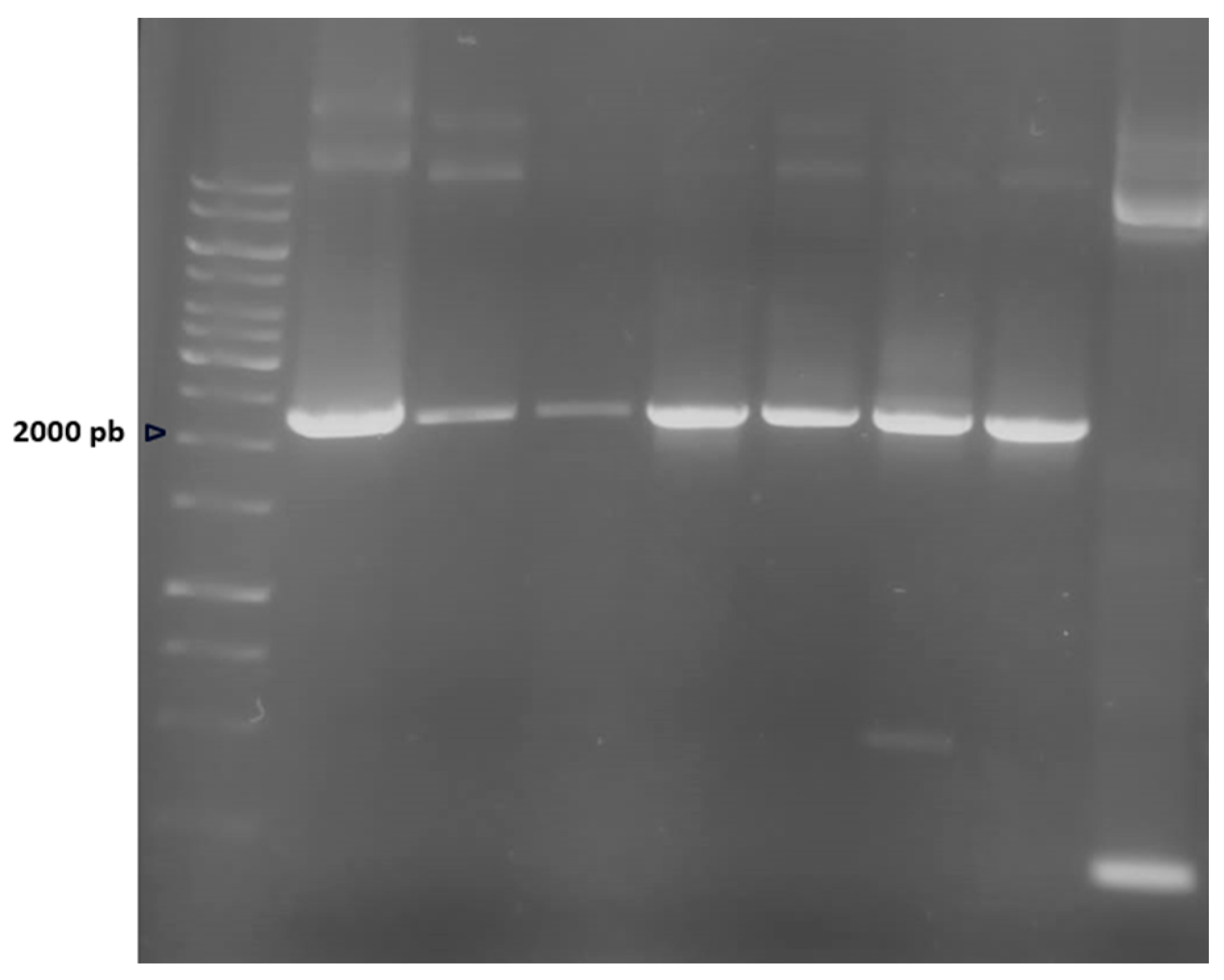
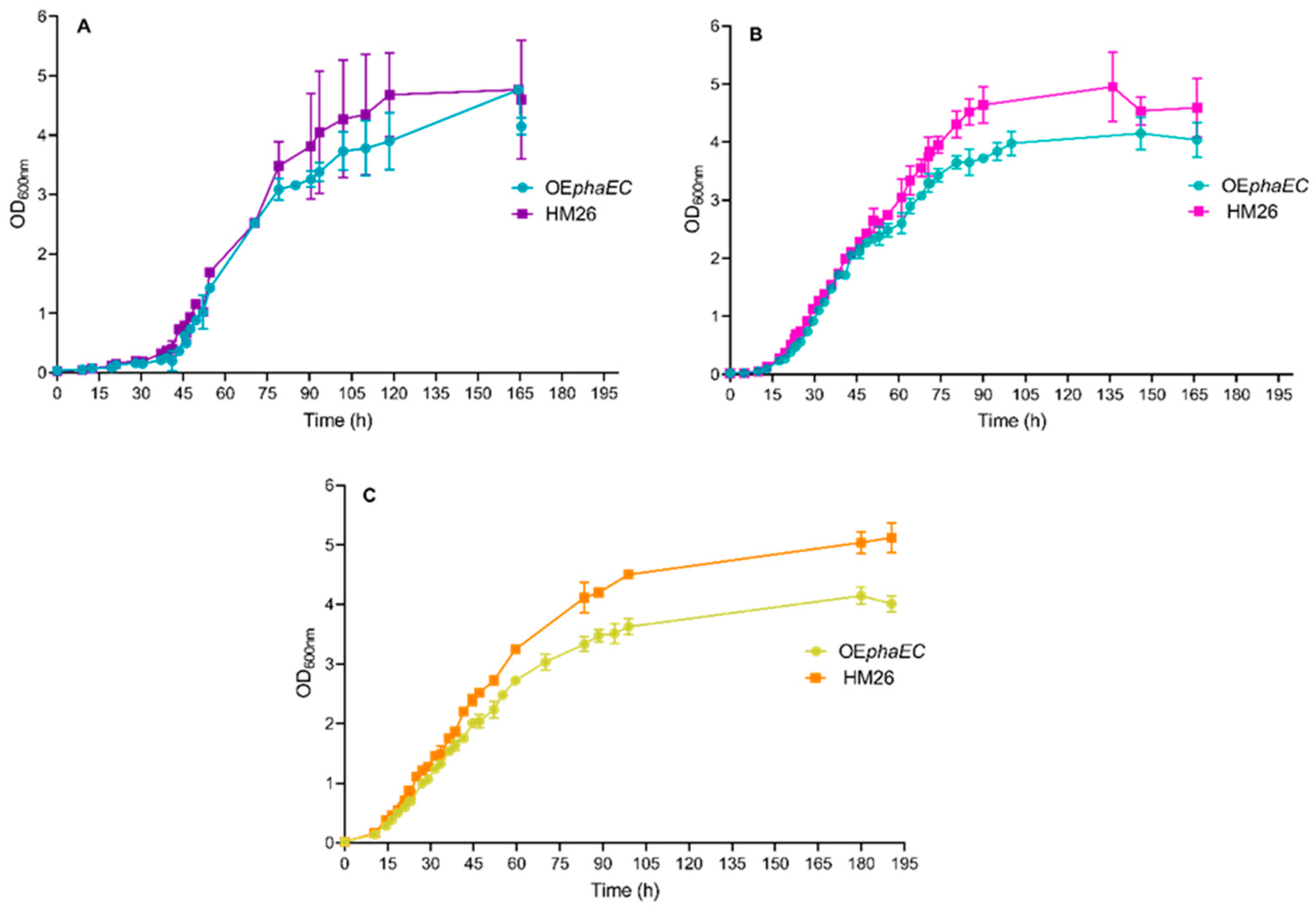

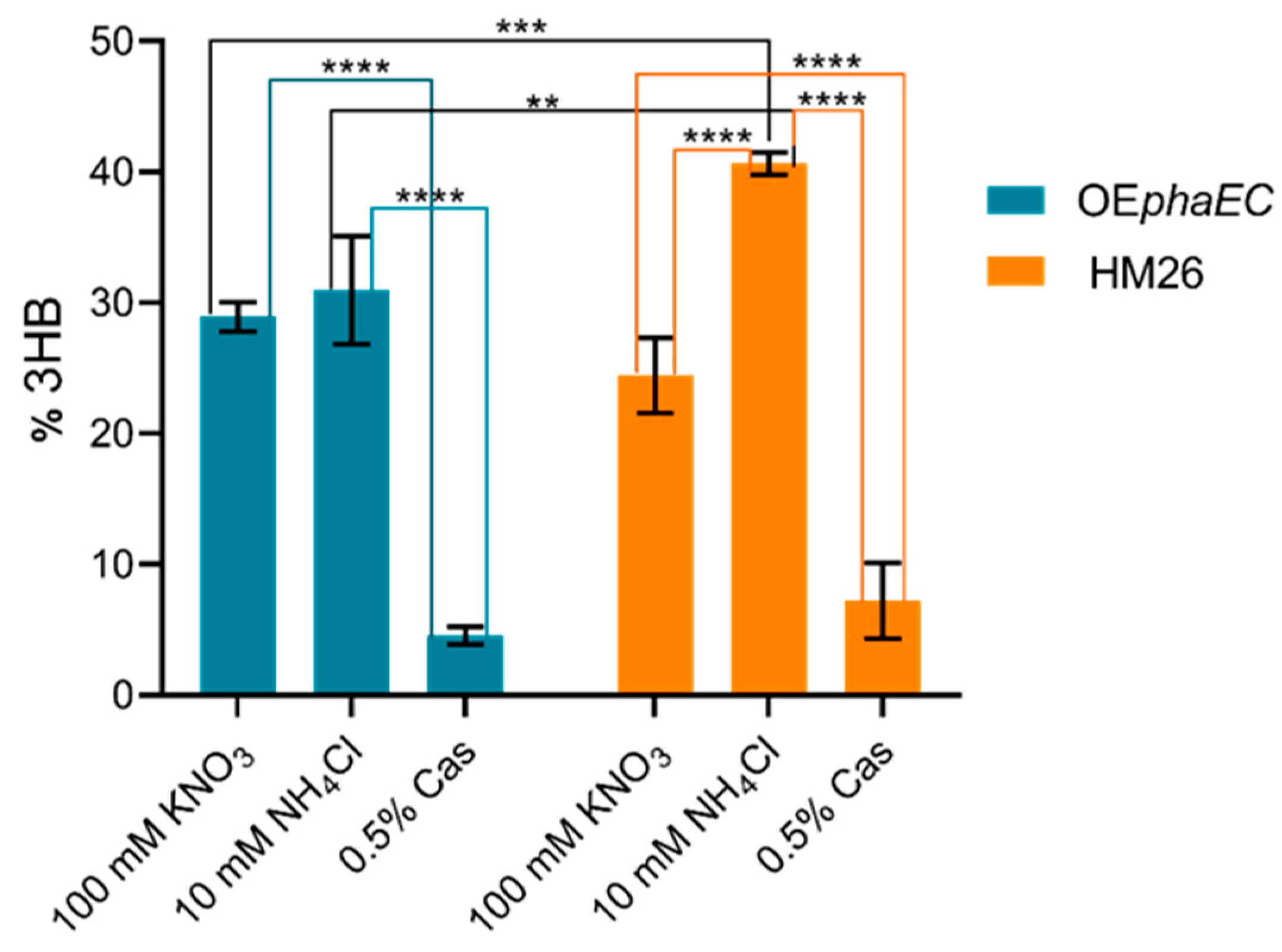


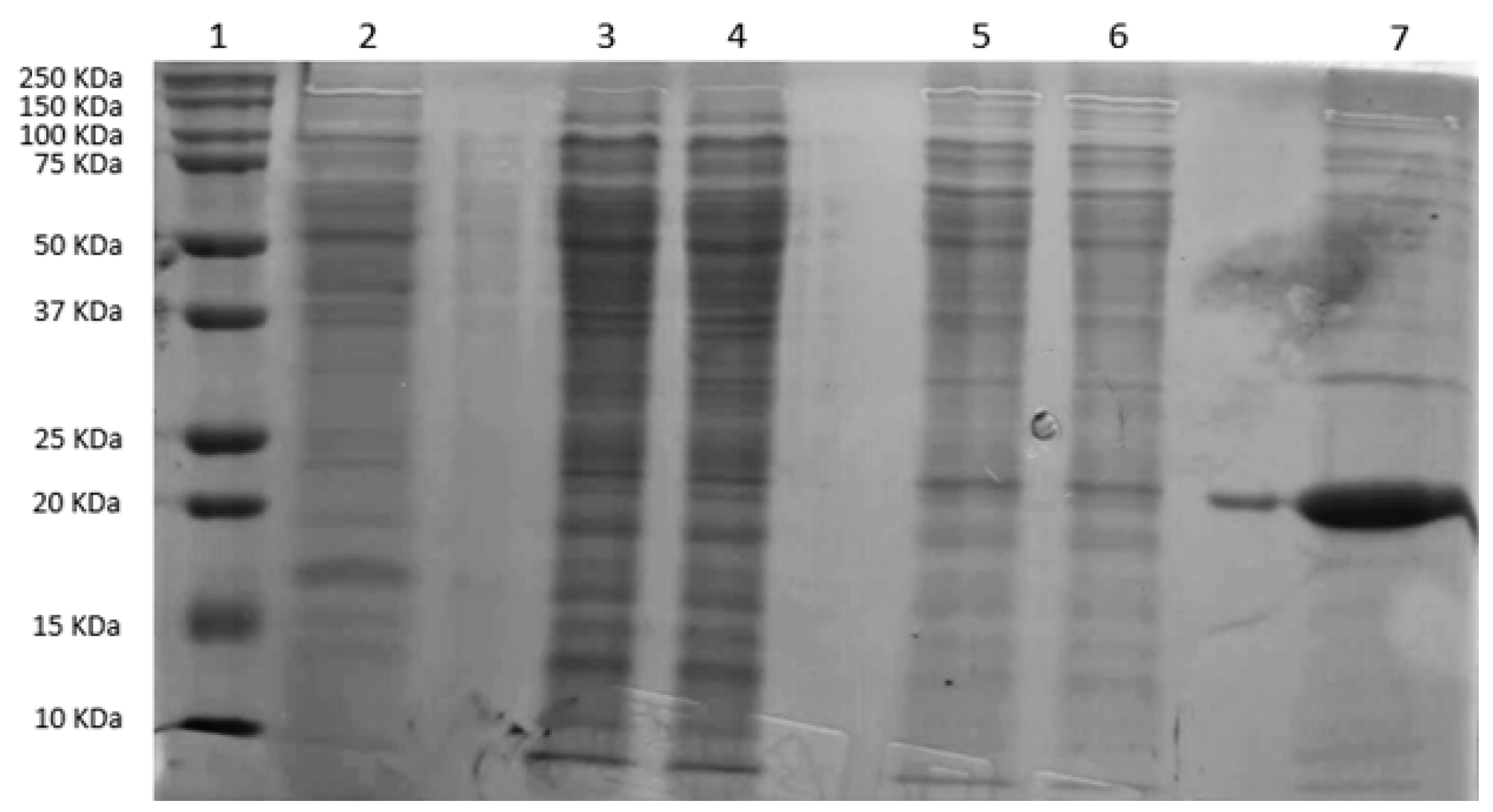
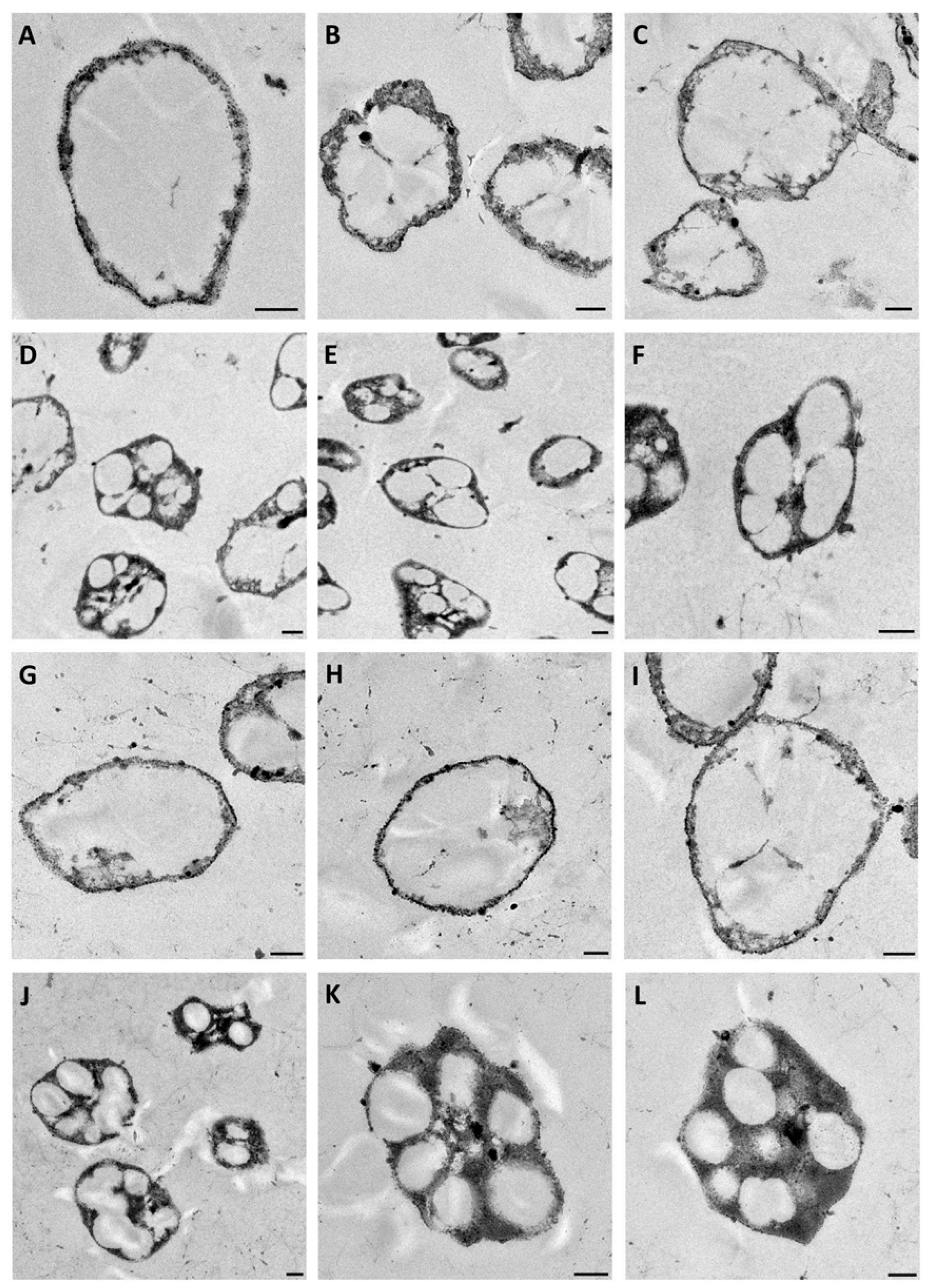
| Media | %PHBV (OEphaEC) | %PHBV (HM26) |
|---|---|---|
| KNO3 | 32.9 ± 1.3 | 27.4 ± 3.2 |
| NH4Cl | 34.3 ± 4.8 | 44.2 ± 1.41 |
| Casamino acids | 5.2 ± 0.8 | 8.1 ± 3.1 |
| Media | %PHBV (OEphaEC) | %PHBV (HM26) |
|---|---|---|
| KNO3 | 10.8 ± 0.3 | 9.2 ± 0.4 |
| NH4Cl | 8.4 ± 0.7 | 7.0 ± 1.0 |
| Casamino acids | 10.2 ± 0.5 | 11 ± 4 |
Disclaimer/Publisher’s Note: The statements, opinions and data contained in all publications are solely those of the individual author(s) and contributor(s) and not of MDPI and/or the editor(s). MDPI and/or the editor(s) disclaim responsibility for any injury to people or property resulting from any ideas, methods, instructions or products referred to in the content. |
© 2025 by the authors. Licensee MDPI, Basel, Switzerland. This article is an open access article distributed under the terms and conditions of the Creative Commons Attribution (CC BY) license (https://creativecommons.org/licenses/by/4.0/).
Share and Cite
Simica, A.; Segovia, Y.; Navarro-Sempere, A.; Martínez-Espinosa, R.M.; Pire, C. Advanced Strategies for Poly(3-hydroxybutyrate-co-3-hydroxyvalerate) Production: PHA Synthase Homologous Overexpression in the Extremophile Haloferax mediterranei. Mar. Drugs 2025, 23, 166. https://doi.org/10.3390/md23040166
Simica A, Segovia Y, Navarro-Sempere A, Martínez-Espinosa RM, Pire C. Advanced Strategies for Poly(3-hydroxybutyrate-co-3-hydroxyvalerate) Production: PHA Synthase Homologous Overexpression in the Extremophile Haloferax mediterranei. Marine Drugs. 2025; 23(4):166. https://doi.org/10.3390/md23040166
Chicago/Turabian StyleSimica, Alexandra, Yolanda Segovia, Alicia Navarro-Sempere, Rosa María Martínez-Espinosa, and Carmen Pire. 2025. "Advanced Strategies for Poly(3-hydroxybutyrate-co-3-hydroxyvalerate) Production: PHA Synthase Homologous Overexpression in the Extremophile Haloferax mediterranei" Marine Drugs 23, no. 4: 166. https://doi.org/10.3390/md23040166
APA StyleSimica, A., Segovia, Y., Navarro-Sempere, A., Martínez-Espinosa, R. M., & Pire, C. (2025). Advanced Strategies for Poly(3-hydroxybutyrate-co-3-hydroxyvalerate) Production: PHA Synthase Homologous Overexpression in the Extremophile Haloferax mediterranei. Marine Drugs, 23(4), 166. https://doi.org/10.3390/md23040166







